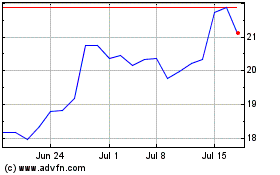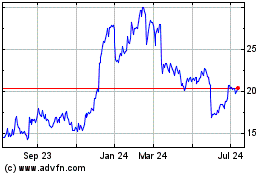Apple Inc. launched a broadside Wednesday against wireless phone
companies, saying it will for the first time finance iPhone sales
directly to customers without requiring them to be tied to any
particular carrier.
The offer, revealed along with a new line of products, marks a
sharp turn in the relationship between Apple, which needs to sell
tens of millions of new phones each year, and such wireless giants
as AT&T Inc., and Verizon Communications Inc., which rely on
the iPhone to attract customers to their cellular plans in the
highly competitive U.S. market.
Carriers have been instrumental in the success of the iPhone,
the ubiquitous device that accounted for about 56% of Apple's $183
billion in sales last year. But the new finance offer reflects
competing pressures on Apple, which seeks more buyers to upgrade
their phones each year, and the wireless carriers, which look to
keep their customers from switching to a rival.
Apple will offer a monthly fee of $32.41 over 24 months for its
cheapest iPhone model under the new program announced Wednesday at
the latest iPhone launch. The deal allows customers to get a new
device each year, as well as select their carrier with each
upgrade, according to the Apple website.
Denny Strigl, Verizon's former chief operating officer, said
Apple's move is a sign it wants to wrest control of customers from
wireless carriers. Companies that control the customer relationship
have more leverage in pricing and sales, he said.
If customers go to Apple to finance their phones and choose a
carrier, for example, Apple will be able to steer that customer's
decision, and possibly guide them toward a carrier with a cheaper
service, according to Mr. Strigl.
Wireless carriers have been replacing traditional two-year
contracts that restrict upgrades with installment plans that spread
the price out over two years. That can be painful for Apple because
those plans make clear the cost of the device, prompting some
customers to delay buying the latest iPhone.
The average upgrade time in the U.S. has risen from 18.2 months
in 2010 to an estimated 26.3 months in 2015, according to data from
telecom consultant Chetan Sharma.
Apple rolled out two new smartphones Wednesday—the iPhone 6s and
6s Plus. They are the same size as the current iPhone 6 and 6 Plus
but have improved cameras and a "3-D Touch" feature that allows
people to interact with smartphone screens in new ways.
It is unclear whether the new features will draw the same
customer response as the iPhone 6 and 6 Plus. In the three full
quarters those phones have been sold, iPhone revenues have grown
more than 50% from the same period a year earlier.
This isn't the first time that Apple has veered into the
carriers' territory. Last year, it launched an iPad with a cellular
SIM card that allowed customers to select their wireless carrier on
the spot.
Apple's new iPhone program, which includes a more robust
warranty, doesn't provide any savings on the device. For a
16-gigabyte iPhone 6s, the payments would end up being about $778,
which is equal to the combined $649 price of the phone and the
included $129 Apple Care coverage. An iPhone 6s Plus with 128
gigabytes of storage costs $949.
"The simple truth is, on an installment plan, any iPhone you
want is pretty affordable," Apple's senior vice president of
world-wide marketing Phil Schiller said Wednesday.
A Verizon spokesman said the company "would love to sell them
the device," but the most important thing is for customers to
choose Verizon for wireless service.
Mike Sievert, chief operating office of T-Mobile praised Apple's
move, saying it would allow customers to try out other
carriers.
Sprint Chief Executive Marcelo Claure said in an interview that
the tension between carriers and Apple is less about customer
control and more about two year contracts, which discouraged
customers from buying new iPhones each year.
"Apple is trying to do nothing more than shorten the cycle so
they can sell more iPhones," he said, adding that he believed
that's what customers want, too. Since Sprint launched an annual
upgrade plan last month, 90% of new customers have bought it.
The largest wireless carriers have been cutting prices and
changing how they structure their cellular and data plans as they
compete in a U.S. market where most people have a cellphone and
don't often switch carriers. The companies have moved away from
subsidizing smartphones to using installment plans where customers
generally pay the cost of the phone over two years.
Tech companies have complained in recent years about the cost of
wireless service. While a new iPhone 6s costs $649, two years of
paying Verizon for a 3 gigabyte monthly data plan is more than
twice that. And tech companies have been exploring ways to compete
in the wireless market. Google Inc. earlier this year launched its
own wireless service called Project Fi, which resells wireless
service from T-Mobile and Sprint under the Google brand.
For Apple, a financing plan that allows upgrades after 12 months
may help lock in a group of customers that automatically take the
new phone each year, thus stabilizing a core of phone sales. That
is important as smartphones improve and consumers are inclined to
keep their phones longer.
"Apple's move is perhaps a bit threatening, in that it
incrementally erodes the carrier's relationship with the customer,"
said Craig Moffett, senior analyst at MoffettNathanson. But it does
have a silver lining, Mr. Moffett said, because carriers typically
lose money each time they sell a handset. Wireless service is the
real cash cow, he said.
Ultimately, the shift could help smaller carriers, like T-Mobile
and Sprint, which are fighting to steal customers from the
dominance of AT&T and Verizon, Macquarie Research analyst Kevin
Smithen said.
"But churn may increase for everyone," he said.
Daisuke Wakabayashi contributed to this article.
Write to Thomas Gryta at thomas.gryta@wsj.com and Ryan Knutson
at ryan.knutson@wsj.com
Access Investor Kit for "Apple, Inc."
Visit
http://www.companyspotlight.com/partner?cp_code=P479&isin=US0378331005
Subscribe to WSJ: http://online.wsj.com?mod=djnwires
(END) Dow Jones Newswires
September 09, 2015 22:05 ET (02:05 GMT)
Copyright (c) 2015 Dow Jones & Company, Inc.
SentinelOne (NYSE:S)
Historical Stock Chart
From Mar 2024 to Apr 2024

SentinelOne (NYSE:S)
Historical Stock Chart
From Apr 2023 to Apr 2024
